Decebal Constantin Mocanu
Leave it to the Specialist: Repair Sparse LLMs with Sparse Fine-Tuning via Sparsity Evolution
May 29, 2025

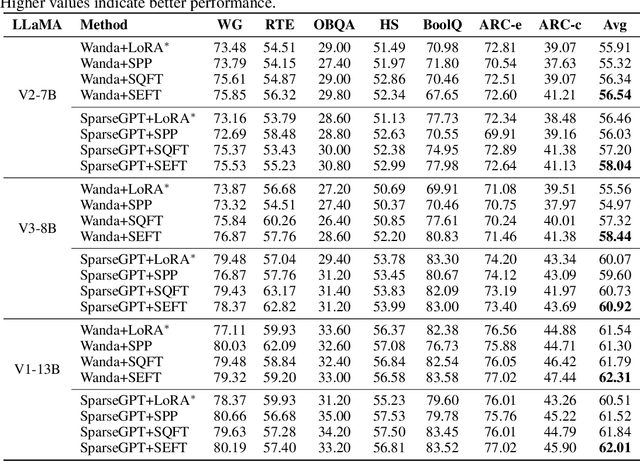
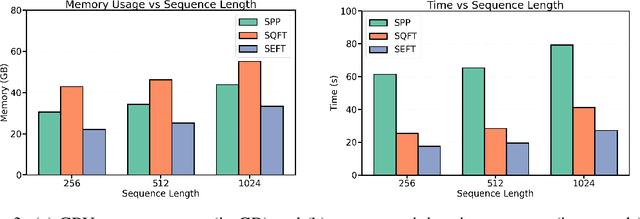
Abstract:Large language models (LLMs) have achieved remarkable success across various tasks but face deployment challenges due to their massive computational demands. While post-training pruning methods like SparseGPT and Wanda can effectively reduce the model size, but struggle to maintain model performance at high sparsity levels, limiting their utility for downstream tasks. Existing fine-tuning methods, such as full fine-tuning and LoRA, fail to preserve sparsity as they require updating the whole dense metrics, not well-suited for sparse LLMs. In this paper, we propose Sparsity Evolution Fine-Tuning (SEFT), a novel method designed specifically for sparse LLMs. SEFT dynamically evolves the sparse topology of pruned models during fine-tuning, while preserving the overall sparsity throughout the process. The strengths of SEFT lie in its ability to perform task-specific adaptation through a weight drop-and-grow strategy, enabling the pruned model to self-adapt its sparse connectivity pattern based on the target dataset. Furthermore, a sensitivity-driven pruning criterion is employed to ensure that the desired sparsity level is consistently maintained throughout fine-tuning. Our experiments on various LLMs, including LLaMA families, DeepSeek, and Mistral, across a diverse set of benchmarks demonstrate that SEFT achieves stronger performance while offering superior memory and time efficiency compared to existing baselines. Our code is publicly available at: https://github.com/QiaoXiao7282/SEFT.
NeuroTrails: Training with Dynamic Sparse Heads as the Key to Effective Ensembling
May 23, 2025Abstract:Model ensembles have long been a cornerstone for improving generalization and robustness in deep learning. However, their effectiveness often comes at the cost of substantial computational overhead. To address this issue, state-of-the-art methods aim to replicate ensemble-class performance without requiring multiple independently trained networks. Unfortunately, these algorithms often still demand considerable compute at inference. In response to these limitations, we introduce $\textbf{NeuroTrails}$, a sparse multi-head architecture with dynamically evolving topology. This unexplored model-agnostic training paradigm improves ensemble performance while reducing the required resources. We analyze the underlying reason for its effectiveness and observe that the various neural trails induced by dynamic sparsity attain a $\textit{Goldilocks zone}$ of prediction diversity. NeuroTrails displays efficacy with convolutional and transformer-based architectures on computer vision and language tasks. Experiments on ResNet-50/ImageNet, LLaMA-350M/C4, among many others, demonstrate increased accuracy and stronger robustness in zero-shot generalization, while requiring significantly fewer parameters.
Sparse-to-Sparse Training of Diffusion Models
Apr 30, 2025Abstract:Diffusion models (DMs) are a powerful type of generative models that have achieved state-of-the-art results in various image synthesis tasks and have shown potential in other domains, such as natural language processing and temporal data modeling. Despite their stable training dynamics and ability to produce diverse high-quality samples, DMs are notorious for requiring significant computational resources, both in the training and inference stages. Previous work has focused mostly on increasing the efficiency of model inference. This paper introduces, for the first time, the paradigm of sparse-to-sparse training to DMs, with the aim of improving both training and inference efficiency. We focus on unconditional generation and train sparse DMs from scratch (Latent Diffusion and ChiroDiff) on six datasets using three different methods (Static-DM, RigL-DM, and MagRan-DM) to study the effect of sparsity in model performance. Our experiments show that sparse DMs are able to match and often outperform their Dense counterparts, while substantially reducing the number of trainable parameters and FLOPs. We also identify safe and effective values to perform sparse-to-sparse training of DMs.
LiMTR: Time Series Motion Prediction for Diverse Road Users through Multimodal Feature Integration
Oct 21, 2024Abstract:Predicting the behavior of road users accurately is crucial to enable the safe operation of autonomous vehicles in urban or densely populated areas. Therefore, there has been a growing interest in time series motion prediction research, leading to significant advancements in state-of-the-art techniques in recent years. However, the potential of using LiDAR data to capture more detailed local features, such as a person's gaze or posture, remains largely unexplored. To address this, we develop a novel multimodal approach for motion prediction based on the PointNet foundation model architecture, incorporating local LiDAR features. Evaluation on the Waymo Open Dataset shows a performance improvement of 6.20% and 1.58% in minADE and mAP respectively, when integrated and compared with the previous state-of-the-art MTR. We open-source the code of our LiMTR model.
Dynamic Sparse Training versus Dense Training: The Unexpected Winner in Image Corruption Robustness
Oct 03, 2024



Abstract:It is generally perceived that Dynamic Sparse Training opens the door to a new era of scalability and efficiency for artificial neural networks at, perhaps, some costs in accuracy performance for the classification task. At the same time, Dense Training is widely accepted as being the "de facto" approach to train artificial neural networks if one would like to maximize their robustness against image corruption. In this paper, we question this general practice. Consequently, we claim that, contrary to what is commonly thought, the Dynamic Sparse Training methods can consistently outperform Dense Training in terms of robustness accuracy, particularly if the efficiency aspect is not considered as a main objective (i.e., sparsity levels between 10% and up to 50%), without adding (or even reducing) resource cost. We validate our claim on two types of data, images and videos, using several traditional and modern deep learning architectures for computer vision and three widely studied Dynamic Sparse Training algorithms. Our findings reveal a new yet-unknown benefit of Dynamic Sparse Training and open new possibilities in improving deep learning robustness beyond the current state of the art.
Are Sparse Neural Networks Better Hard Sample Learners?
Sep 13, 2024



Abstract:While deep learning has demonstrated impressive progress, it remains a daunting challenge to learn from hard samples as these samples are usually noisy and intricate. These hard samples play a crucial role in the optimal performance of deep neural networks. Most research on Sparse Neural Networks (SNNs) has focused on standard training data, leaving gaps in understanding their effectiveness on complex and challenging data. This paper's extensive investigation across scenarios reveals that most SNNs trained on challenging samples can often match or surpass dense models in accuracy at certain sparsity levels, especially with limited data. We observe that layer-wise density ratios tend to play an important role in SNN performance, particularly for methods that train from scratch without pre-trained initialization. These insights enhance our understanding of SNNs' behavior and potential for efficient learning approaches in data-centric AI. Our code is publicly available at: \url{https://github.com/QiaoXiao7282/hard_sample_learners}.
Unveiling the Power of Sparse Neural Networks for Feature Selection
Aug 08, 2024



Abstract:Sparse Neural Networks (SNNs) have emerged as powerful tools for efficient feature selection. Leveraging the dynamic sparse training (DST) algorithms within SNNs has demonstrated promising feature selection capabilities while drastically reducing computational overheads. Despite these advancements, several critical aspects remain insufficiently explored for feature selection. Questions persist regarding the choice of the DST algorithm for network training, the choice of metric for ranking features/neurons, and the comparative performance of these methods across diverse datasets when compared to dense networks. This paper addresses these gaps by presenting a comprehensive systematic analysis of feature selection with sparse neural networks. Moreover, we introduce a novel metric considering sparse neural network characteristics, which is designed to quantify feature importance within the context of SNNs. Our findings show that feature selection with SNNs trained with DST algorithms can achieve, on average, more than $50\%$ memory and $55\%$ FLOPs reduction compared to the dense networks, while outperforming them in terms of the quality of the selected features. Our code and the supplementary material are available on GitHub (\url{https://github.com/zahraatashgahi/Neuron-Attribution}).
Dynamic Data Pruning for Automatic Speech Recognition
Jun 26, 2024
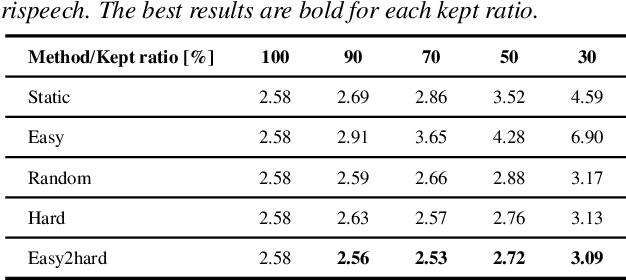
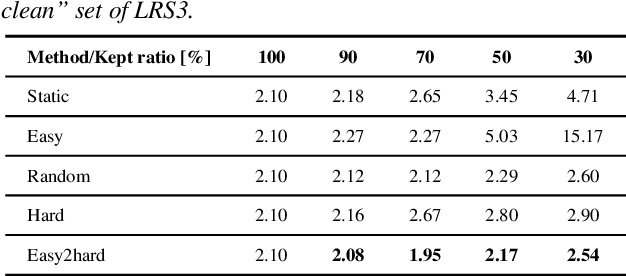
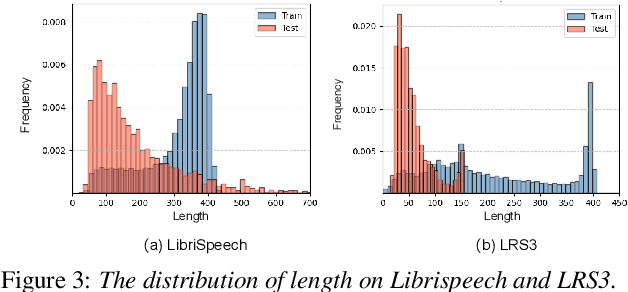
Abstract:The recent success of Automatic Speech Recognition (ASR) is largely attributed to the ever-growing amount of training data. However, this trend has made model training prohibitively costly and imposed computational demands. While data pruning has been proposed to mitigate this issue by identifying a small subset of relevant data, its application in ASR has been barely explored, and existing works often entail significant overhead to achieve meaningful results. To fill this gap, this paper presents the first investigation of dynamic data pruning for ASR, finding that we can reach the full-data performance by dynamically selecting 70% of data. Furthermore, we introduce Dynamic Data Pruning for ASR (DDP-ASR), which offers several fine-grained pruning granularities specifically tailored for speech-related datasets, going beyond the conventional pruning of entire time sequences. Our intensive experiments show that DDP-ASR can save up to 1.6x training time with negligible performance loss.
Boosting Robustness in Preference-Based Reinforcement Learning with Dynamic Sparsity
Jun 10, 2024Abstract:For autonomous agents to successfully integrate into human-centered environments, agents should be able to learn from and adapt to humans in their native settings. Preference-based reinforcement learning (PbRL) is a promising approach that learns reward functions from human preferences. This enables RL agents to adapt their behavior based on human desires. However, humans live in a world full of diverse information, most of which is not relevant to completing a particular task. It becomes essential that agents learn to focus on the subset of task-relevant environment features. Unfortunately, prior work has largely ignored this aspect; primarily focusing on improving PbRL algorithms in standard RL environments that are carefully constructed to contain only task-relevant features. This can result in algorithms that may not effectively transfer to a more noisy real-world setting. To that end, this work proposes R2N (Robust-to-Noise), the first PbRL algorithm that leverages principles of dynamic sparse training to learn robust reward models that can focus on task-relevant features. We study the effectiveness of R2N in the Extremely Noisy Environment setting, an RL problem setting where up to 95% of the state features are irrelevant distractions. In experiments with a simulated teacher, we demonstrate that R2N can adapt the sparse connectivity of its neural networks to focus on task-relevant features, enabling R2N to significantly outperform several state-of-the-art PbRL algorithms in multiple locomotion and control environments.
MaDi: Learning to Mask Distractions for Generalization in Visual Deep Reinforcement Learning
Dec 23, 2023



Abstract:The visual world provides an abundance of information, but many input pixels received by agents often contain distracting stimuli. Autonomous agents need the ability to distinguish useful information from task-irrelevant perceptions, enabling them to generalize to unseen environments with new distractions. Existing works approach this problem using data augmentation or large auxiliary networks with additional loss functions. We introduce MaDi, a novel algorithm that learns to mask distractions by the reward signal only. In MaDi, the conventional actor-critic structure of deep reinforcement learning agents is complemented by a small third sibling, the Masker. This lightweight neural network generates a mask to determine what the actor and critic will receive, such that they can focus on learning the task. The masks are created dynamically, depending on the current input. We run experiments on the DeepMind Control Generalization Benchmark, the Distracting Control Suite, and a real UR5 Robotic Arm. Our algorithm improves the agent's focus with useful masks, while its efficient Masker network only adds 0.2% more parameters to the original structure, in contrast to previous work. MaDi consistently achieves generalization results better than or competitive to state-of-the-art methods.
 Add to Chrome
Add to Chrome Add to Firefox
Add to Firefox Add to Edge
Add to Edge